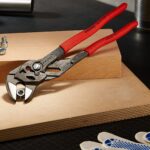Tackling plumbing repairs under your sink can feel tricky, especially when space is tight and standard tools just won’t fit. That’s where a basin wrench comes in handy. This specialized tool is designed to reach those hard-to-access nuts behind your faucet, making your repair job smoother and faster.
If you’ve ever struggled to loosen or tighten faucet nuts, learning how to use a basin wrench will save you time and frustration. With a bit of guidance, you’ll be able to handle faucet installations and repairs like a pro, even in the most cramped spots. Let’s dive into the basics of using a basin wrench so you can tackle your next plumbing task with confidence.
Understanding the Basin Wrench
The basin wrench is a crucial tool for plumbing tasks under the sink. Knowing its purpose and features helps you use it effectively in tight spaces behind faucets.
What Is a Basin Wrench?
A basin wrench is a specialized plumbing tool designed to tighten and loosen nuts located in confined spaces, such as under sinks. It features a long handle with a pivoting jaw that grips nuts on faucet tailpieces. You use it when standard wrenches can’t reach due to cramped areas and awkward angles.
Key Features and Design
- Pivoting Jaw: Adjusts to grip nuts of varying sizes, typically 7/8 to 1 1/4 inches.
- Long Handle: Provides leverage and reach, enabling access to low or deep-set fasteners.
- Spring-Loaded Head: Keeps the jaw securely engaged on the nut, preventing slips during turning.
- Reversible Grip: Allows both clockwise and counterclockwise rotation without repositioning your hand.
- Compact Size: Fits easily into narrow spaces where wrench handles must maneuver around pipes.
These features combine to make the basin wrench indispensable for faucet installations and maintenance where space restricts conventional tools.
Preparing to Use a Basin Wrench
Getting ready to use a basin wrench ensures a smoother, safer faucet repair or installation. Knowing your faucet type and gathering the right tools sets you up for success.
Identifying the Right Faucet Type
Determine whether your faucet has threaded or compression fittings before you begin. Threaded nuts require a basin wrench for loosening or tightening, while compression fittings might need a different tool. Check if the faucet tailpieces have hex nuts that the basin wrench jaws can grip. Faucets with hard-to-reach mounting nuts beneath the sink benefit most from using a basin wrench.
Gathering Necessary Tools and Safety Tips
Collect essential tools including your basin wrench, adjustable wrench, pliers, and a flashlight for visibility under the sink. Shut off the water supply valves to avoid leaks during the process. Wear safety glasses to protect your eyes from debris or accidental slips. Clear the cabinet space below the sink for easy access and place a towel or bucket to catch any water drips. Proper preparation minimizes delays and safety risks while using the basin wrench.
Step-by-Step Guide on How to Use a Basin Wrench
Mastering the basin wrench ensures efficient faucet repairs in tight spaces. Follow these detailed steps to use the wrench effectively and avoid damage.
Adjusting the Wrench to Fit
Begin by setting the pivoting jaw to match the nut size on your faucet’s tailpiece. Rotate the jaw until it firmly grips the nut without slipping. Use the reversible grip to position the jaw for clockwise or counterclockwise turns depending on whether you’re tightening or loosening.
Positioning the Wrench Under the Sink
Insert the basin wrench vertically through the cabinet opening, guiding the jaw toward the nut behind the faucet. Align the jaw so it sits securely on the flat surfaces of the nut. Ensure the long handle extends downward for leverage and keeps the wrench steady in the confined space.
Turning the Fastener with Proper Technique
Apply steady pressure on the handle in the intended direction—clockwise to tighten or counterclockwise to loosen. Keep the wrench jaw locked on the nut by maintaining consistent force. Adjust the wrench angle slightly if the nut resists, taking care not to apply excessive torque that might strip the fastener.
Removing or Tightening the Faucet
After loosening, continue turning the nut until it detaches from the faucet tailpiece, allowing faucet removal. For tightening, turn the fastener until it feels snug but avoid over-tightening to prevent damage to threads or fixtures. Check for secure hold by lightly wiggling the faucet once fastened.
Tips for Effective Use of a Basin Wrench
Using a basin wrench correctly enhances its efficiency and extends its lifespan. Applying practical strategies combat typical issues and keep the tool in optimal condition.
Common Challenges and How to Overcome Them
You may encounter limited space, stubborn nuts, or slipping jaws when using a basin wrench. Position the wrench’s pivoting jaw securely on the nut to prevent slipping. Apply steady, controlled force rather than sudden jerks to loosen tight nuts. Use a flashlight or mirror to improve visibility in cramped under-sink areas. If the nut resists, spray penetrating oil and allow it to sit before trying again. Adjust the handle angle for better leverage without straining your wrist. Keep your hand steady and let the wrench’s spring-loaded head maintain grip pressure.
Maintenance and Care for Your Basin Wrench
You prolong your basin wrench’s usability through regular cleaning and inspection. Wipe the jaws and handle with a clean cloth after each use to remove grime and moisture. Lubricate pivot points occasionally with light machine oil to ensure smooth movement. Store your wrench in a dry place to prevent rust and corrosion. Inspect the jaws for wear or damage and replace the wrench if the grip weakens significantly, as compromised jaws can slip and damage nuts. Maintaining the wrench prevents failures during critical plumbing tasks.
Conclusion
Mastering the basin wrench opens up a whole new level of ease when working on faucets in tight spaces. With the right approach and a bit of practice, you’ll handle those hard-to-reach nuts confidently and efficiently. Keeping your tool well-maintained ensures it’s always ready for the next job.
By incorporating these techniques, you’ll save time and avoid unnecessary frustration during your plumbing projects. Your faucet repairs and installations will feel smoother, giving you the satisfaction of a job done right.
Frequently Asked Questions
What is a basin wrench used for in plumbing?
A basin wrench is used to tighten or loosen nuts located under sinks, mainly behind faucets, where space is tight and standard tools can’t reach.
Why is a basin wrench better than regular wrenches for under-sink repairs?
Its long handle and pivoting jaw allow it to grip nuts in hard-to-reach, confined spaces, making faucet installation and repairs easier and faster.
How do I prepare before using a basin wrench?
Turn off the water supply, clear the area under the sink, gather necessary tools, wear safety glasses, and identify your faucet type to ensure smooth repair or installation.
How do I adjust a basin wrench for different nut sizes?
The pivoting jaw automatically adjusts to various nut sizes, and you can position the wrench so the jaw grips the nut securely for easy turning.
What’s the best way to apply force when using a basin wrench?
Use steady, consistent pressure to avoid slipping or damaging the nut, and make sure the wrench’s jaw is firmly gripping the fastener.
How can I improve visibility when using a basin wrench under the sink?
Use a flashlight or headlamp to illuminate tight spaces, which helps position the wrench correctly and reduces mistakes.
What should I do if nuts are stuck or rusted?
Apply penetrating oil to loosen stubborn nuts and wait a few minutes before attempting to turn with the basin wrench.
How do I maintain my basin wrench for long-term use?
Regularly clean the tool, lubricate pivot points, and inspect for wear to keep it functioning smoothly and extend its lifespan.
Can a basin wrench be used on all types of faucets?
Yes, it works on most faucets with threaded or compression fittings, as its adjustable jaw fits various nut sizes.
Is using a basin wrench difficult for beginners?
With basic preparation and following a simple step-by-step guide, beginners can quickly learn to use a basin wrench effectively and safely.


